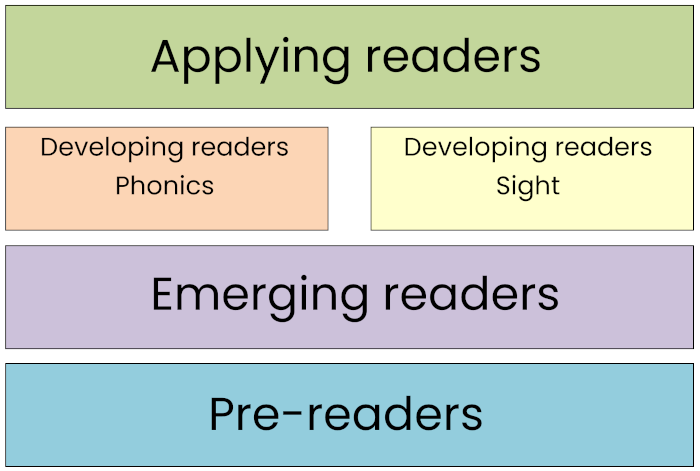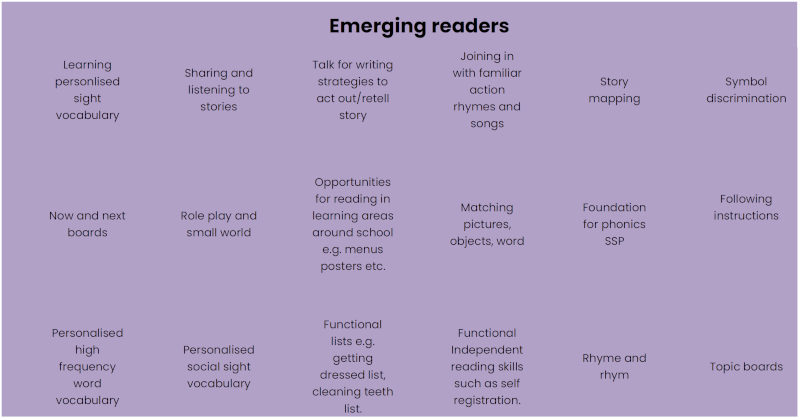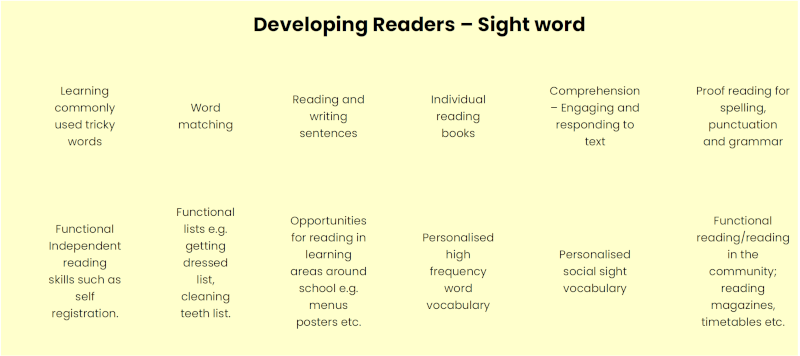
• Level 1 - Pre-readers
• Level 2 - Emerging Readers
• Level 3 - Developing Readers – Phonics
• Level 3 - Developing Readers – Sight
• Level 4 – Applying Readers
Pre-readers

- Light sensory room
- Sound sensory room
- Resonance boards
- Dark tents
- An inviting reading area in classroom for child led reading for pleasure might include mirrored area, resonance board, uv lighting (black and white books).
- Little rooms
- Rebound Therapy
Pre-readers
It is important that pupils experience and retain a series of pre-requisites to learning in order to move on to develop recognised skills in literacy. At this level we teach key processes which lead to the development of early visual and auditory skills and then to learning symbolic representation and pre-reading skills. These include early tracking skills, self-awareness, a sense of rhythm, pattern and order and communication skills. For many children in reading level 1 these requisites will be a continuous process throughout their time at school.
Using the engagement model to base children’s early reading skills on:
- Anticipation
- Realisation
- Persistence
- Exploration
- Initiation
When pupil’s symbol discrimination is becoming more developed (e.g. they can discriminate between 3-5 key symbols) and their engagement in pre-reading skills as outlined above demonstrates they are ready pupils will transition to reading road B.
Emerging Readers
Children working at emerging readers (Level 2) are pupils who have emerging early reading skills. They will continue to work on the skills in level 1 in more sophisticated and complex ways. They are able to access and understand at a simple level personal reading books (E.g. identifying Mum, Dad, themselves, pets etc.) In order to begin to access reading as a distinct stage of literacy, children work on the following re-requisite skills:
- Symbolic discrimination – so that children process the visual information in a symbol through rapid shape discrimination
- Short term memory – the ability to retain information essential for fluent reading to both make sense of what has been read and decode.
- Awareness of words as units of sound , and being able to produce and imitate same sounds such as animal noises.
- Auditory discrimination – of environmental, instrumental and body sounds, with attention to support children to listen attentively.
- Appreciation and enjoyment of rhythm and rhyme.
- Left to right sequencing in a range of functional contexts.
- Vocabulary development – the acquisition of words and associated concepts through a focus on understanding, expressive use of the word and through to generalization, application and association.
Pupils working within reading level 2 will be developing emerging early reading skills such as familiar logos, symbols and personalised high frequency words such as their name, favourite characters etc. Children in this pathway will systematically access foundations for phonics (Little Wandle) developing early sound awareness alongside personal sight vocabulary. (See phonological awareness Appendix 3) They will be developing the skills to unravel a love of reading in a way that is personal to them. They will develop understanding that books convey meaning in a way that is relevant to them.
These pupils will be working within or towards pre keystage standard 1 English language comprehension. As stated in The Little Wandle “Introducing the SEND programme for the graduated approach” (Appendix 2) “Children who are at Standard 1 do not need phonics instruction. Use the Foundations for phonics activities (on the Little Wandle website) to grow phonemic awareness and develop listening skills.”

Provision
• An inviting reading area in classroom for child led reading for pleasure, includes different texts such as catalogues, magazines, fiction and non-fiction books.
• Computer and ipads with programs to access reading
• Reading for purpose in classroom role play are, e.g. reading menus, timetables, shopping lists etc.
• Access to the school library for development of reading skills, choosing and finding relevant texts.
• Access to shared role play areas to encourage environmental reading skills e.g. The shop, the hairdressers etc.
• Access to the local area to develop real world reading skills such as locating shops, hospital, doctors etc.
The route out of level 2 (Emerging readers) is thoroughly dependent on the individual pupil and their skills. At Sunningdale school we promote Systematic Synthetic Phonics (SSP) through fidelity to the Little Wandle Scheme as the main route to start the process of formally decoding text and making meaning from it. However, for some pupils who have gaps in their skills a whole word approach becomes more appropriate. This is decided at an individual level depending on how pupils progress within foundation for phonics.
Developing Readers
Level 3 – Developing readers: Phonics
Pupils in Level 3 – Developing readers are pupils who have developing reading skills. They are able to read a range of personal sight vocabulary. Phase 1 SSP (Little Wandle foundation for phonics) is embedded in their learning and they are ready to move on to more formalised reading strategies. These pupils will be developing a much more concrete understanding of reading for meaning. They can gain information from text and books. Pupils will have demonstrated that they are ready to further develop their understanding of Systematic synthetic phonics.
These pupils will be working on phonological awareness skills and language comprehension skills that include:
• Developing knowledge of grapheme-phoneme correspondence
• Developing blending and segmenting skills
• Developing the ability to blend words through teacher-led blending
• Learning the grapheme and phoneme for common diagraphs
• Practicing decoding skills by reading fully decodable books well-matched to their secure phonic knowledge
• Accessing symbol supported text
• Learning commonly used tricky words (i/e/, ones needed beyond the phoneme sequence they currently know)
• Reading a range of carefully selected high quality texts with an adult, in groups or individually with rich opportunities to develop language comprehension skills.
• Identifying features of the book, such as pictures and words and answering simple retrieval, prediction , and inference questions.
• Having opportunities to select and handle books, identify favourites, revisit and re-read familiar stories, interact with the book and adults.
• Reading simply, repetitive, personal books
• Developing one to one correspondence with finger pointing
Provision
• Individual SSP sessions
• Individual reading books – book bands for differentiation
• Individual reading with staff during the school day
• Reading for research – using the internet to find out facts/information
• Reading comprehension tasks
• General reading opportunities throughout the day e.g. reading out questions, reading emails etc.
• Home – school reading programme
• An inviting reading area in classroom for child led reading for pleasure, includes different texts such as catalogues, magazines, fiction and non-fiction books.
• Computer and ipads with programs to access reading
• Reading for purpose in classroom role play are, e.g. reading menus, timetables, shopping lists etc.
• Access to the school library for development of reading skills, choosing and finding relevant texts.
• Access to shared role play areas to encourage environmental reading skills e.g. The shop, the hairdressers etc.
• Access to the local area to develop real world reading skills such as locating shops, hospital, doctors etc

Level 3 – Developing readers: Sight Word
Pupils in Level 3 – Developing readers are pupils who have developing reading skills. They are able to read a range of personal sight vocabulary. These pupils will not demonstrate the skills able to retain the knowledge needed to decode words using the Systematic Synthetic phonics approach. They will however demonstrate the ability to retain whole words and store the word visually in long-term memory. This means they can recall it automatically. These pupils may demonstrate poorer reading comprehension and require a focus that blends both sight vocabulary acquisition and reading comprehension strategies. E.g. using blank level questions.
These pupils will be working on sight word vocabulary and language comprehension skills that include:
• Developing a range of sight word vocabulary
• Accessing symbol supported text
• Learning commonly used tricky words (i/e/, ones needed beyond the phoneme sequence they currently know)
• Reading a range of carefully selected high quality texts with an adult, in groups or individually with rich opportunities to develop language comprehension skills.
• Identifying features of the book, such as pictures and words and answering simple retrieval, prediction , and inference questions.
• Having opportunities to select and handle books, identify favourites, revisit and re-read familiar stories, interact with the book and adults.
• Reading simply, repetitive, personal books
• Developing one to one correspondence with finger pointing
• Word to picture matching using simple picture noun vocabulary that is meaningful and motivating to the child.
• Simple word matching to understand that words are units of meaning, looking at words carefully and differentiating between their shape, e.g. word bingo, snap etc.
The range of sight vocabulary that might be taught is listed below:
Personalised High interest vocabulary
There isn’t a definitive list because these will be words which are chosen to reflect particular interests the learner has. The learner may suggest them or they may be suggested by family and friends, they may be elicited through conversation with staff members through looking at personal photo albums, websites apps etc.
Start with a few and build up. There doesn’t need to be lots because this is about high interest and quality if more important than quantity.
Personalised high frequency vocabulary
Most high frequency vocabulary lists are unsuitable as the words they contain cannot be represented pictorially. However, the See and Learn reading programme gives an extensive set of words which can be pictured and which occur most frequently in children’s early language development. The programme was developed with relatively able children with Down Syndrome so the vocabulary should not be taught exhaustively and systematically unless the See and Learn programme itself is being delivered, but it does provide a ready source which can be drawn upon to expand the pupil’s lexicon.
Personalised topic or project related vocabulary
This is key words which relate topics or projects or stories in which the pupil is interested. Learning to read key words can help involve the pupil in such diverse activities as labelling or captioning pictures, recording the main parts of an activity with which they have been involved, or creating mind-maps using symbols/words.
Personalised social sight vocabulary
Social sight words are those which learners are most likely to encounter in their immediate or extended environment and need to understand in order to negotiate it independently. Words such as Entrance, Exit, Push, Pull, Look Left, Look Right, Bust Stop, Stop as well as signs used in supermarket aisles to indicate basic items such as Bread, Sugar, Tea, Coffee, Milk, Cheese etc. In addition brand signage such as MacDonald’s, Greggs, Tesco.

• Individual systematic sight vocabulary sessions
• Individual reading books
• Individual reading with staff during the school day
• Reading for research – using the internet to find out facts/information
• Reading comprehension tasks
• General reading opportunities throughout the day e.g. reading out questions, reading emails etc.
• Home – school reading programme
• An inviting reading area in classroom for child led reading for pleasure, includes different texts such as catalogues, magazines, fiction and non-fiction books.
• Computer and ipads with programs to access reading
• Reading for purpose in classroom role play area, e.g. reading menus, timetables, shopping lists etc.
• Access to the school library for development of reading skills, choosing and finding relevant texts.
• Access to shared role play areas to encourage environmental reading skills e.g. The shop, the hairdressers etc.
• Access to the local area to develop real world skills such as locating shops.
Level 4 – Applying readers
These pupils will move beyond early reading. They will have a secure knowledge of all phase 2 and 3 phonemes and be able to use and apply their ‘Grow the Code’ knowledge to decode and encode more complex spelling patterns at Phase 4 and 5. They will continue to work on their prosody, fluency, and comprehension skills.